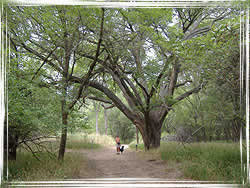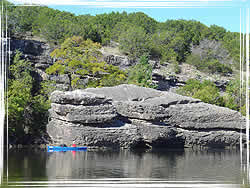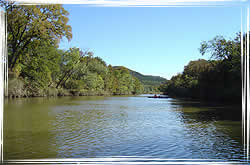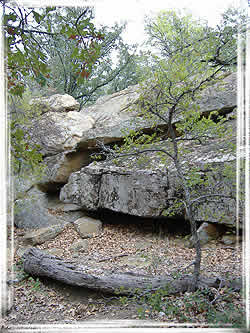Texas Eco-Regions
Western Cross Timbersback to Eco-Regions Map
Elevation
Elevation ranges from 400 feet above sea level in the Trinity River basin to over 1,700 feet in the west.
Precipitation
Tarrant County in the east receives 32 inches of rain per year while Wichita County in the northwest averages 27 inches per year.
Topography
This eco-region is hilly, rolling and well-drained. In the center of this region there is more variation in topography and ranching is more common, whereas the northern and southern regions contain flatter areas and agriculture is more prevalent.
Soils
The Western Cross Timbers soils are neutral to acidic whereas the prairie soils are alkaline. This is why post oaks grow in the Western Cross Timbers and not the prairies.
Vegetation Description
The Western Cross Timbers eco-region is a transitional area between the once prairie, now winter wheat growing regions to the west, and the forested low mountains or hills of eastern Oklahoma and Texas. The region stretches from southern Kansas into central Texas, and contains irregular plains with some low hills and tablelands. It is a mosaic of forest, woodland, savanna, and prairie. The Western Cross Timbers eco-region is not as suitable for growing corn and soybeans as the Central Irregular Plains to the northeast. The transitional natural vegetation of little bluestem grassland with scattered blackjack oak and post oak trees is used mostly for rangeland and pastureland. Streamside areas contain bottomland forests of such species as pecan, bur oak, American and slippery elm, ashes, cottonwood, sugarberry and black willow. Texas ash has been found in the lower wetter areas. The more upland sites in the prairie region contain little woody vegetation unless fire has been eliminated. Upland sites in the Western Cross Timbers predominantly contain post oak, blackjack oak, cedar elm, juniper, and sugarberry, Texas red oak and in the Western Cross Timbers escarpment, live oak. On the top of the hillside it is common to find post oaks mixed with live oaks. On many hillsides where fire has been eliminated there is a mix of Ashe junipers, Spanish oaks, and red oaks. Most junipers in this area are Ashe junipers, and there are occasional eastern red cedars in the eastern areas of this eco-region.
Impacts of Fire
Fire has a major impact on the vegetation, especially in the prairie areas. Traditionally these were fire dominated regions and periodic burns kept much of the woody vegetation at bay, which favored the growth of grasses. As fire has been eliminated, much of this area has been invaded by woody vegetation such as juniper and mesquite and is no longer a prairie. Within the wooded areas, fire often kept the understory clear and open.
Historical Information
From Irving, Washington, 1886. A Tour of the Prairies. John B. Alden, New York: " The Cross Timber is about forty miles in breadth and stretches over a rough country of rolling hills, covered with scattered tracts of post-oak and black-jack; with some intervening valleys, which at proper seasons, would afford good pasturage. It is very much cut up by deep ravines, which in the rainy seasons, are the beds of temporary streams, tributary to the main rivers, and these are called "branches". The whole tract may present a pleasant aspect in the fresh time of the year, when the ground is covered with herbage; when the trees are in their green leaf, and the glens are enlivened by running streams. I shall not easily forget the mortal toil and vexations of the flesh and spirit that we underwent occasionally, in our wanderings through the Cross Timber. It was like struggling through forests of cast iron." pp. 78-79. * Courtesy of The Ancient Cross Timbers Consortium, http://www.uark.edu/misc/xtimber/.
Other
Oil production has been a major activity in this region for over eighty years, as have ranching and farming. Many areas around the metroplex are being subjected to urban sprawl and the large land holdings in those areas are being divided in to smaller parcels of land.





